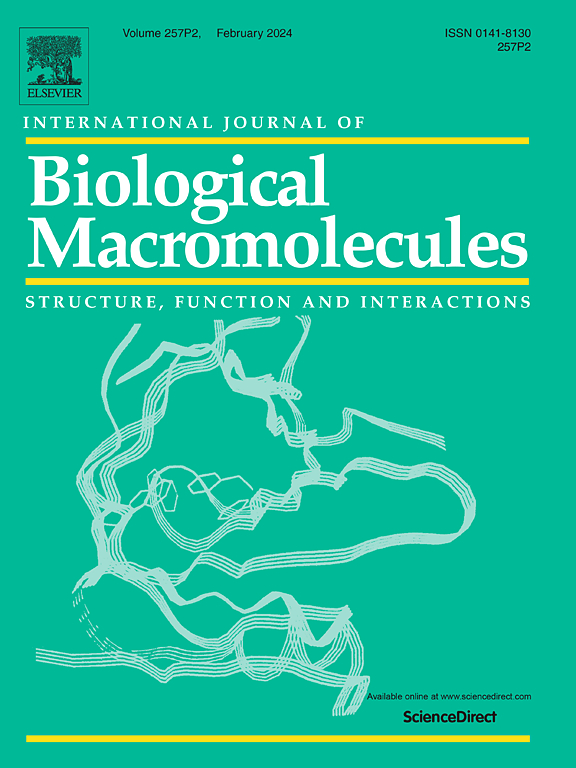Impact of Imperata Cylindrica polysaccharide on liver lipid metabolism disorders caused by hyperuricemia
IF 8.5
1区 化学
Q1 BIOCHEMISTRY & MOLECULAR BIOLOGY
International Journal of Biological Macromolecules
Pub Date : 2024-12-01
DOI:10.1016/j.ijbiomac.2024.137592
引用次数: 0
Abstract
Elevated uric acid levels are associated with lipid metabolism disorders. The effects of Imperata cylindrica polysaccharide (ICPC-a) were explored using a hyperuricemia mouse model and a uric acid-induced HepG2 hepatocyte model. ICPC-a significantly improved total cholesterol, triglycerides, low-density lipoprotein levels, and hepatic lipid deposition in hyperuricemia mice. The liver/body weight ratio decreased, and markers of liver damage, inflammation, and dyslipidemia improved. Metabolomics analysis suggested that ICPC-a modulates lipid metabolism by influencing the glycerophospholipid pathway and the enzyme LPCAT3. Stable HepG2 cell lines with knocked-down LPCAT3 were constructed, and western blot and RT-PCR were used to assess the impact of its knockdown on lipid metabolism under uric acid stimulation. In cells with reduced LPCAT3 expression, ICPC-a was still able to alleviate uric acid-induced lipid accumulation, though the effect was less pronounced compared to cells with normal LPCAT3 levels. However, the effectiveness was diminished compared to cells where LPCAT3 was not knocked down. These findings indicated that LPCAT3 was an important target through which ICPC-a regulated lipid metabolism disorders induced by hyperuricemia. These discoveries emphasized that ICPC-a, as a prebiotic, could modulate hepatic lipid accumulation and inflammation, contributing to the maintenance of hepatic lipid homeostasis.
白茅多糖对高尿酸血症引起的肝脂代谢紊乱的影响
尿酸水平升高与脂质代谢紊乱有关。研究人员利用高尿酸血症小鼠模型和尿酸诱导的 HepG2 肝细胞模型探讨了白茅多糖(ICPC-a)的作用。ICPC-a能明显改善高尿酸血症小鼠的总胆固醇、甘油三酯、低密度脂蛋白水平和肝脏脂质沉积。肝脏/体重比下降,肝损伤、炎症和血脂异常的指标也得到改善。代谢组学分析表明,ICPC-a 通过影响甘油磷脂途径和 LPCAT3 酶来调节脂质代谢。研究人员构建了敲除 LPCAT3 的稳定 HepG2 细胞系,并使用 Western 印迹和 RT-PCR 评估了在尿酸刺激下敲除 LPCAT3 对脂质代谢的影响。在 LPCAT3 表达减少的细胞中,ICPC-a 仍能缓解尿酸诱导的脂质积累,但与 LPCAT3 水平正常的细胞相比,效果并不明显。不过,与未敲除 LPCAT3 的细胞相比,ICPC-a 的效果有所减弱。这些发现表明,LPCAT3是ICPC-a调控高尿酸血症诱导的脂质代谢紊乱的一个重要靶点。这些发现强调了ICPC-a作为一种益生元,可以调节肝脏脂质积累和炎症,有助于维持肝脏脂质平衡。
本文章由计算机程序翻译,如有差异,请以英文原文为准。
求助全文
约1分钟内获得全文
求助全文
来源期刊
CiteScore
13.70
自引率
9.80%
发文量
2728
审稿时长
64 days
期刊介绍:
The International Journal of Biological Macromolecules is a well-established international journal dedicated to research on the chemical and biological aspects of natural macromolecules. Focusing on proteins, macromolecular carbohydrates, glycoproteins, proteoglycans, lignins, biological poly-acids, and nucleic acids, the journal presents the latest findings in molecular structure, properties, biological activities, interactions, modifications, and functional properties. Papers must offer new and novel insights, encompassing related model systems, structural conformational studies, theoretical developments, and analytical techniques. Each paper is required to primarily focus on at least one named biological macromolecule, reflected in the title, abstract, and text.

 求助内容:
求助内容: 应助结果提醒方式:
应助结果提醒方式:


